|
As all those who participate in AGSS in one form or another know, the experience of working with STEM in an all-girls environment is invaluable. For all participants that are about to graduate 8th grade, you may think that this road is over for you. In fact, for anyone who wishes to pursue it, the road is just beginning.
Many of our volunteers were once participants themselves, and graduating to being a volunteer from a participants is a great way to not only help the organization but also discover your own passions as you go through high school. Every year, we try to find new ways to improve the participant experience, and bringing voices to the leadership table who have direct experience with that perspective is crucial. Also, we love to have volunteers from all high school grade levels, especially the younger ones who can grow into eventually leading their own workshops and taking on more responsibility (but if you just want to be a normal volunteer, that’s great too!). Aside from helping the organization, becoming a volunteer has been extremely rewarding and beneficial for me personally throughout high school. Besides just gaining a few extra service hours, it’s honestly just a simple way to have fun! I’ve met and made friends with other volunteers that don’t go to my school and become closer with those I already knew through shared passions and experiences. An unexpected benefit of volunteering for me is that I actually learn more STEM too. Coincidentally, the week after volunteering at our ecology workshop, three of the terms I learned from that workshop showed up in my biology class. After my first year volunteering, I joined the leadership team, meaning that I get to help develop and lead workshops. This has been a really cool experience as I’ve gotten to choose the subjects that I enjoy teaching and pull together all my favorite experiences from learning them into a few activities. I’ve grown in my ability to take on more responsibility and a leading role, speaking in front of a group, and countless other skills that I can take with me throughout high school, college, and beyond. The main message to get across here is that volunteering with AGSS is definitely something you should try. Whether you want to become a regular volunteer or just have a free weekend, everyone can learn something while also having a good time. If you’re interested, reach out! Feel free to ask a volunteer at AGMT or via social media for more information. See you next year!
0 Comments
My first experience at AGSS was when I was in fifth grade, attending the Geometry Workshop. I was a bit intimidated at first, but mostly curious about what was in store. When I stepped foot into the library’s multipurpose room, the bright tablecloths and welcoming smiles immediately brought joy to me face. I felt like I belonged. We spent the workshop learning about shapes - not just the ones I saw in my school textbook, but ones that went beyond the classroom basics. An origami-lover at heart, I was excited to learn that our activities involved folding intricate, 3D origami shapes.
Now, 7 years later as a high school senior, I’ve had time to reflect on what it was that made me want to volunteer. Part of it was the challenging and intriguing nature of the workshops. They’re not necessarily topics that you will see in any classroom or syllabus. These are often unique and interesting subjects that are explored on a deeper level than students in elementary and middle schools will have experience with. That’s what made my experiences as a participant so fun, and it’s what I strive for as a volunteer and member of the leadership team. AGSS is where I discovered the fun in learning. I wasn’t being forced to attend; I was able to choose what workshops sounded interesting and become self-motivated to learn and experiment. The beauty of it all is that I’m able to give back to the organization that sparked my love for STEM — whether it was that first Geometry Workshop I attended, the Python Workshop that introduced me to computer science, or the Physics Workshop that I taught with my friend Sophia two years ago. At every workshop, I learn just as much from the students who attend as they do from the workshop’s contents. Their eagerness to learn and ask questions inspire me everyday to do the same — think boldly and pursue curiosity. As a volunteer, I aspire to instill that enthusiasm and sense of belonging that I first felt as a participant. There aren’t many spaces where I can be surrounded by an inclusive and safe environment. Back then, I didn’t understand just how valuable it was to be surrounded by older role models who looked like me and peers who were like myself. I’ve worked in labs and been in classrooms where most people there are not female. I’m grateful to always be able to return to AGSS and call it my home. It’s truly shaped my passion for collaboration and developed my love of learning. I encourage you to cherish the times and memories you make at AGSS -- and who knows? You, too, may return as a volunteer one day! Although women have participated in science, technology, engineering, and math for as long as the subjects have existed, only in recent years has it become normalized. We are still a long way off from full representation in STEM, but have made great strides, and in order to recognize this progress, here are a few of the greatest milestones for women in STEM throughout history.
4th Century - Hypatia of Alexandria, a prominent mathematician, heads her city’s school of philosophy, the first woman in such a position 18th Century - the Enlightenment brings new opportunities for women in science, including professorships, recognition, and the ability to work independently 23 January 1849 - Elizabeth Blackwell is the first woman to earn a medical degree in the United States December 1903 - Marie Curie is recognized with the Nobel Prize in Physics for work on radiation, and is the first woman to receive a Nobel in any category 1939-45 - Women take on new STEM positions during World War II, including Grace Hopper and Rachel Carson, and many continue with them after the war is over 1972 - Title IX guarantees education without sex discrimination 2017 - For the first time, women make up the majority of first-year medical students, with mathematics and physical sciences being on track to follow suit These are just a few of the incredible gains women have fought for throughout history in order to participate in STEM fields, and there is no doubt that this will continue. However, it is imperative to this progress that we continue to support and encourage more women to pursue their dreams in STEM and set a precedent for future generations. 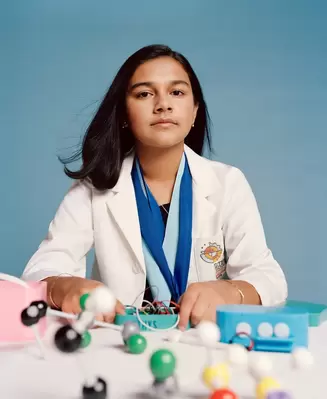 In 2020, Gitanjali Rao became the first ever winner of Time’s Kid of the Year award. At only fifteen years of age, she won on the basis of her “astonishing work using technology to tackle issues ranging from contaminated drinking water to opioid addiction and cyberbullying,” according to Time’s Magazine. This included Kindly, both an app and a chrome extension that uses AI to prevent cyberbullying before it happens. “You type in a word or phrase, and it’s able to pick it up if it’s bullying, and it gives you the option to edit it or send it the way it is,” Rao explained in the same Time’s article. Another one of her impressive accomplishments was her innovation sessions. Rao organizes lessons, labs, and contests to help foster young minds with innovative ideas. “The students that I work with, they just don’t know where to start,” Rao said. “If you give them that spark that they can then build off…that means one more person in this world wants to come up with ideas to solve problems.” Now, three years later, Rao is as motivated and extraordinary as she was at fifteen. She is a current freshman at MIT, where she hopes to major in biological engineering and minor in entrepreneurship and innovation. She was also honored at the White House’s first Girls Leading Change celebration this past October “for her work promoting science and innovation among youth, locally and globally, and inspiring them with several inventions,” according to MIT News. “My dream is to work on developing solutions to some of the most complex problems in our communities, and possibly someday run a biotech company,” she told MIT News. In addition to all her work with innovation and invention, Rao has written two books—“A Young Inventor’s Guide to STEM: 5 Steps to Problem Solving for Students, Educators, and Parents,” and “A Young Innovators Guide to Planning For Success,” the latter of which will come out in June 2024. Rao is an inspiration to young minds in STEM, and proof that there are people fighting hard to change and improve the world we live in today. No matter what age, she is a testament to the fact that you can make a difference for our future. Almost everyone in our modern society has heard of Neil Armstrong - the first person to walk on the moon! But how about Judy Resnik, Annie Easley, Mae C. Jemison, and Sally Ride? Most of us don’t know the names of all the women who are an integral part of engineering, building, or flying at NASA. So let’s change that. Judy Resnik was the fourth woman to fly in space on the STS-41-D mission in 1984. On this mission, she operated the mechanical arm that moved objects outside of the spacecraft. But not only that; she was also an electrical engineer, software engineer, biomedical engineer, pilot, and, of course, NASA astronaut (nasa.gov). She impacted so many lives while working at NASA, and yet, she remains unrecognized. “In 1955, [Annie] Easley began her career as a ‘human computer,’ doing computations for researchers. This involved analyzing problems and doing calculations by hand” (nasa.gov). Later, Easley continued on to be a computer programmer for NASA, translating and researching several different power systems. In fact, she conducted critical research on battery technology used for early hybrid vehicles. Without her, NASA, and the world, could not have made the advancements that it did. Mae C. Jemison became the first African American woman to travel in space. She was among 15 candidates chosen from around 2,000 for NASA’s astronaut program. She was the science mission specialist on STS-47 Spacelab-J (futurism), and the first woman of color in space. She will continue to inspire us all today and long in the future. Lastly, Sally Ride was the first American woman to be up in space. She flew on Mission STS-7, before flying up again on Mission STS-41-G. She was the only woman on the flight, with four male crewmates. In an interview, Ride lamented, “I came to appreciate what an honor it was to be selected to be the first to get a chance to go into space.” Sally Ride will continue to be an inspiration to us all. There are so many women working at NASA and traveling into space that do not get the recognition they deserve. However, at the end of the day, they are out of this world. Last month, Hungarian-American biochemist Katalin Karikó won the Nobel Prize in Physiology or Medicine with her work partner, Drew Weissman. They were awarded the Nobel Prize for their efforts in speeding up the process of developing the COVID-19 vaccine with the help of mRNA-based vaccines that allowed “potent Covid vaccines to be made in less than a year,” according to the New York Times.
Dr. Karikó and Dr. Weissman have been researching mRNA for almost twenty years. In 2005 they published findings stating that “mRNA could be altered and delivered effectively into the body to activate the body’s protective immune system.” This discovery became instrumental after the global pandemic hit, as governments and scientists rushed to get out an effective vaccine as quickly as possible. The mRNA vaccines allow for a very strong immune response, “including high levels of antibodies that attack a specific infectious disease that has not previously been encountered,” according to a Penn Today article. MRNA vaccines are unique in the sense that no virus is injected to the vaccine recipient at any time. Both Pfizer and Moderna used Dr. Karikó and Dr. Weissman’s mRNA discoveries to create mRNA-based vaccines. In the US alone, “mRNA vaccines make up more than 655 million total doses of SARS-CoV-2 vaccines that have been administered” since December 2020, according to the same Penn Today article. Their findings have forever changed the way in which vaccines work, and may even help protect people against other deadly diseases in the future, including cancer. “Katalin Karikó and Drew Weissman are brilliant researchers who represent the epitome of scientific inspiration and determination,” said Penn President Liz Magill. Dr. Karikó is only the 13th woman to win the Nobel Prize in Physiology or Medicine, out of 227 total laureates. Her incredible discoveries have not only changed the world in terms of medicine and science, but have also paved the way for more women to continue to pursue careers in scientific research and medicine. The idea of changing the world seems, frankly, terrifying. It feels lofty and unattainable, so, understandably, most of us just don’t do it! However, not all steps towards a more perfect future have to be huge leaps. In fact, most of the change is a result of small steps that ALL of us can do. And that’s why it’s so important that all of us work together, slowly taking small steps in order to bridge the gender gap in areas of STEM in universities, workplaces, and beyond.
One step we can take is simply informing our teachers and professors to become more inclusive in their teaching styles and mindsets. In fact, many teachers and professors of STEM subconsciously cater their teaching styles towards men! The Massachusetts Institute of Technology has been working over the past few years to diversify both their faculty and students. By informing our teachers and schools to diversify more, women in STEM will increase, school by school. Another small step all of us can take is ending isolation of women who have interest in STEM. “Many women may perform excellently, but they are not invited to share their ideas.” (IQS Directory). If each of us encourages girls and women to share their ideas and speak up about what they’re passionate about, we are each taking a small step to a future of females. All Girls STEM Society aims to take both these steps. By making sure that each of our volunteers is qualified and gears their teaching towards the girls in the workshop, we are actively staying informed. AGSS gives girls a community where they won’t feel alone by allowing them to share their ideas, partake in all sorts of STEM activities, and to collaborate with each other. AGSS cares about change, and small steps can cause big change. We’ve all heard it before — #womeninSTEM, bridge the gap. It’s no surprise, after all, that’s what All Girls STEM Society believes in! But why is it so important to advocate for women in STEM and bridge this gap? Well, in 2020, as reported by the American Association of University Women (AAUW), women still continue to makeup only 28% of the STEM workforce, despite being 50% of our nation’s population. Not only that, but despite the upward trend in lucrative and highly sought after STEM fields such as computer science, the gender wage gap between men in women is more prevalent than ever.
And that’s another reason why advocating for female involvement in STEM even at young ages is so important — the gender wage gap is STILL a big deal! One would hope that in 2023, we shouldn’t have to be worrying about such a systemically sexist issue, yet women are still, on average, earning only 82% of what their male counterparts earn (PEW Research Center, March 2023). Furthermore, 50% of US adults agree that the reason the gender wage gap is still very much prevalent is because of the way women are viewed in the workforce (PEW Research Center, March 2023). These harmful perspectives not only disproportionately harm women of color, but also women who are in STEM fields, a traditionally male dominated workforce. So, how are organization such as AGSS doing their part to combat these challenges? By exposing young girls do fun opportunities and activities in the STEM fields, we encourage girls to get involved as early as possible! Whether it be candy DNA or block programming, offering girls different outlets and opportunities to explore STEM in contexts often not seen or feasible at school can be an incredibly enriching experience. Speaking from personal experience, had my parents not guided me (or in my elementary school eyes, forced me) to do robotics, I never would've realized that there was so much more to computer science than just sitting in front of a computer, multicolored words on the screen. We aim to help girls build confidence in these STEM skills, skills that will be helpful regardless of what path they continue on --- although, totally no bias, but we'd love for you to continue and explore the world of STEM ;) Women in STEM Spotlight Throughout history, women have made many incredible achievements in the science and mathematics fields. Though their contributions have often been overlooked and overshadowed, without many of these women we would not be where we are today. Among others, women’s developments in space travel, gene editing, and computing programming have changed the world indispensably. To give these women the recognition they deserve, here is a spotlight on three influential and inspirational women in STEM! 1. Katherine Johnson (1918-2020) Born in Virginia, Katherine Johnson was a research mathematician and computer scientist during the 1900s. She is most famous for her calculations of orbital mechanics — essential to the success of the first American space flight. She began her career as a teacher, until 1953 when she started working for the National Advisory Committee for Aeronautics (NACA). She described herself and the women she worked with as “computers who wore skirts,” whose jobs consisted of performing mathematical tasks (such as reading the data from the plane’s black boxes). She quickly impressed the men around her with her knowledge of analytic geometry, which often led to her male colleagues and bosses forgetting to return her to her all-female job post. In 1958 she began working as an aerospace technologist for the Spacecraft Controls Branch, where her mathematical calculations proved essential for American spacecraft. In addition to calculating the trajectory of the first American in space, she calculated the launch window for a 1961 Mercury mission, and was called on specifically by astronaut John Glenn to verify the computer’s numbers. Glenn stated that he would not fly unless Katherine Johnson checked the numbers specifically. “Girls are capable of doing everything men are capable of doing,” said Johnson. And with her impressive and indispensable work, she certainly proved herself right. 2. Jennifer Doudna (1964-present) Born in Washington D.C., Jennifer Doudna is an American biochemist most famous for her work with CRISPR gene editing. She received her undergraduate degree from Pomona College, and has a Ph.D. from Harvard Medical School. Together with Emmanuelle Charpentier (a researcher in microbiology, genetics, and biochemistry), Doudna suggested that CRISPR-Cas9 (an “adaptive immune system that naturally protects cells from DNA virus infections”) could be used for programmable editing of genomes. This proposition became one of the most important biological discoveries in history.. Since her work with CRISPR, Doudna has been an important figure in the "CRISPR revolution. For example, she used CRISPR in 2020 to develop technologies that addressed the COVID-19 pandemic. She is also often called-upon to help with the ethical side of the CRISPR technology (the morality of changing organisms). For her work with CRISPR and their work with genome editing, Doudna and Charpentier received the 2020 Nobel Prize in Chemistry. This was only the fourth time women had been honored with this award. “Just because we are not ready for scientific progress,” said Doudna, “does not mean it won’t happen.” 3. Ada Lovelace (1815-1852) Born in England, Augusta Ada King, Countess of Lovelace (Ada Lovelace) was a mathematician, most famous for the title many bestow her with — the first computer programmer. Her mathematical prowess was visible from a young age, and she was known for questioning basic assumptions others had accepted. This was in part due to her interest in poetry as well as math. To Lovelace, intuition and imagination were necessary to understand scientific concepts. She was a metaphysicist, which refers to “to the studies of what cannot be reached through objective studies of material reality.” Between 1842-1843, Lovelace translated an article written by Italian Luigi Federico into English, and added detailed notes and annotations (named simply “Notes). These notes are critical to the early history of computers, and many say they contain the first computer program. After Lovelace, the first early programming language was called Ada. “The more I study, the more insatiable do I feel my genius for it to be,” she said. Her thirst for knowledge is truly inspirational. After being an AGSS volunteer last year, creating and co-leading my own workshop this year gave me an inside look at how much time and energy goes into the final workshop that everyone experiences. So, this is an overview of our process, specifically using the example of the scratch workshop, for anyone considering volunteering or just wondering how the process runs within AGSS.
The first step for any volunteer who wants to lead a workshop is to create a workshop proposal, most of which are presented at our annual summer volunteer meeting (for current 8th graders interested in volunteering next year, we’d love to have you there!). These proposals generally include an overview of topics the workshop will cover and some ideas for activities. In the scratch workshop, we had planned to have a few shorter challenges with a longer project at the end in our proposal, and included drafts of slides on useful blocks and debugging. After presenting, the people proposing the workshop will receive feedback and ideas of things to add from anyone watching. For example, since our workshop was a very simple overview of scratch, we decided to limit the age range to younger participants who were more likely to have never encountered scratch before. Once a workshop has been approved and put into the schedule, the leader(s) start creating and working on their slides and activities. As it gets closer to the workshop date, the leader(s), president, vice presidents, and curriculum directors (eg. we have directors of technology who would help out with programming workshops) hold 2-3 development meetings, running through activities, giving feedback, and helping to plan. In the first development meeting, we had a first draft of a completed slideshow, with planned activities and the information we wanted to cover. Before the second meeting, the other people present at the meeting went through our slides in more depth and gave us more feedback. Meanwhile, the other workshop leader and I worked on the suggestions we had received during the meeting, such as an extension packet for participants who already knew scratch and a volunteer cheat sheet so they could help the participants even if they didn’t know programming. The second meeting was more detail-oriented, as almost everything was complete. With all of these details worked out, the workshop finally happens! From my experience, I know how much we as volunteers enjoy helping and interacting with all of our participants. Workshops are definitely a highlight of each month for me, and I know we’re all excited to see everyone at the next one! |
AGSS VolunteersThese angels, who encourage and support, share some of their many everlasting experiences with silly, yet driven girls. Archives
April 2024
Categories |
All Girls STEM Society is a 501(c)(3) nonprofit organization.
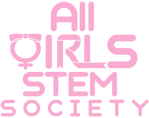
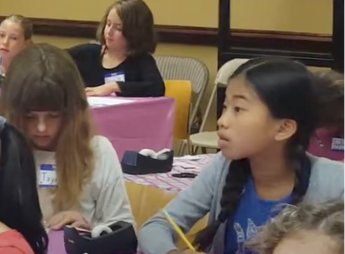
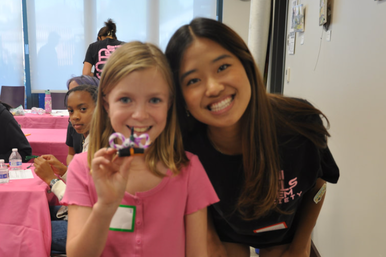
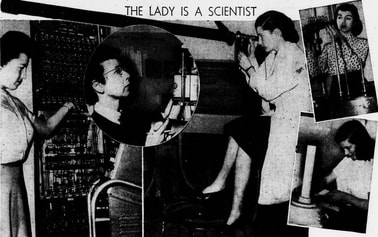
 RSS Feed
RSS Feed